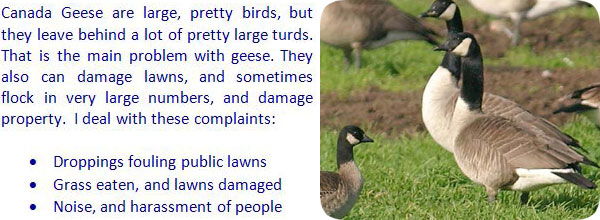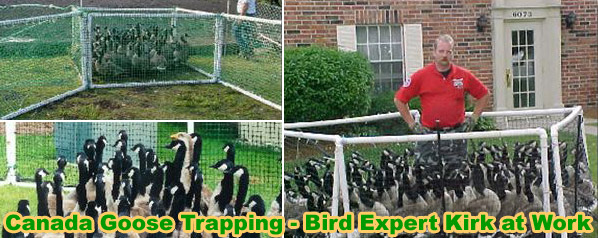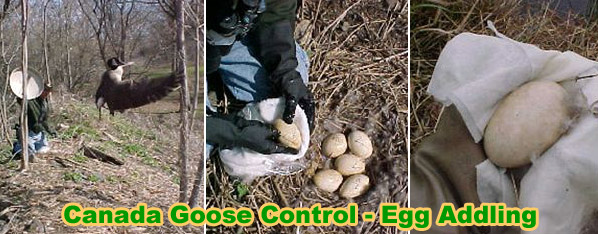- info@wildlifeanimalcontrol.com
Call us for help in your town
Wildlife Control Education
How to Get Rid of Canada Geese

It is my goal to educate the public about Canada Geese, birds, and other wildlife, and
provide tips for safe, effective, and responsible wildlife removal.
HUMANE HINTS: In most cases, you don't need to trap or kill geese at all - just scare them away! NEVER attempt to poison geese. Use herding dogs or loud noises to scare them off. Install netting or fencing
in areas you want to keep goose-free. Read below for how-to hints.
Need goose removal in your hometown? We service over 500 USA locations! Click here to hire us in your town and check prices - updated for year 2020.
How to Get Rid of Canada Geese - Geese are a common bird in North America and are a part of the background in any park, city or backyard. As long as there is a water source nearby, you can be sure to have Canada Geese. These are resilient birds that can live in a variety of different climates, but must like near lakes, ponds, reservoirs, streams or creeks because this is where they get most of their food. Canada Geese usually eat insects and small fish that can be found in water but are also known to eat water plants and seeds/grains that are thrown to them by passer-bys. While it is fine to feed them every once in awhile, feeding geese food can severely damage their digestive system. Not to mention that if you are trying to get rid of them, they will only keep coming back if they know you have food. Most people do not consider

Canada Geese to be a problem, but for some, these birds are a nuisance and are desperate to get rid of them. Geese leave a lot of droppings which are both unsanitary and make all the surfaces around their nests slippery and unsafe. Not only do geese leave massive amounts of droppings that are hazardous, but they make an enormous amount of noise. If the population grows very large, very fast you will hear tremendous amounts of noise and have a problem with geese gangs. Geese gangs are not dangerous, but if you or your pet comes too close to their territory they will chase and honk at you. If you want to get rid of your Canada Geese problem, then try out a few of these tips:
- The key to reducing or getting rid of your Canada Geese population is to make your property as inhospitable as possible. You can do that in many different ways. One way is to NOT FEED THEM. Geese can become domesticated very quickly if they are getting the majority of their food from you. You may even want to put up a sign that says to not feed the geese if there is a chance that people walking by may feed them. Not only will the geese stay close to you, but they will also attract more geese to come and get food from you.
- Put up decoys. Putting up swan decoys has been shown to be effective in getting rid of Canada Geese. Swans and Canada Geese do not get along because both species aggressively protect their young. You do not need to have these all the time, but put them up during the time when the geese are migrating to your area.
- Another way that you can make your property unattractive to geese is to let the grasses around your lake or ponds grow really tall (around 20 inches) and wide (a couple of feet). This makes your property look shaggy and un-kept but letting the plants grow limits the easy access that Canada Geese are used to and chances are they will find somewhere else to nest for the year.
- Canada Geese hate places that change all the time or that has a lot of loud, sudden noises. During the migration seasons, it would be helpful to have an air horn around or something that makes a similar noise to scare the geese away when they try to land on your water. Also, shooting a gun at them (whether you are hunting them or not) will do the same thing. If they sense danger, they will not land there. However, if you are not hunting them for food, please do not purposely shoot at them if you just want to scare them.
More in-detail how-to Canada Geese removal articles:
Information about Canada Goose trapping - analysis and methods for how to trap.
Information about how to kill a Canada Goose - with poison or other methods.
Information about how to keep Canada Geese away - prevention techniques.
Information about how to catch a Canada Goose - remove one stuck in the house.
Information about Canada Goose repellent - analysis of types and effectiveness.

Canada Goose Information & Facts
Canada Goose Appearance: The Canada goose is a large bird, usually weighing around twenty pounds, with a long, black neck and white to gray body. This bird is sometimes more brown than gray, though no specific reason for the color variation exists. These geese have a characteristic white marking on their faces behind the bill and below the eye. The head of this species is always black. Using bodies of water as a primary food and habitat source, the feet of this goose are webbed and strong, able to propel the bird through strong currents. Wing spans are approximately six feet long, enabling the Canada goose to take off while out on the surface of water.Canada Goose Habitat and Behavior: These birds are found mostly in North America with a few scatterings of populations in Europe and Asia. Breeding takes place in Canada and the northern part of the United States near the banks of a body of water. These geese lay three to eight eggs in shallow bowls lined with vegetation once a year. The birds mate for life and will find a new mate if one is killed. Goose eggs are a primary source of food for predators such as foxes, raccoons, ravens, and bears.
The Canada goose is a migratory bird, leaving its northern summer habitats for warmer climates during the winter season. This migration instinct has lessened in some flocks where food is available throughout the year regardless of temperature. Migrating geese can be identified by the known V-shape of their flocks while in flight. This shape makes the group more aerodynamic. The bird at the head of the V will rotate the energy-sapping position with others. Because they are migratory, certain federal regulations protect geese from unauthorized removal, relocation, and extermination.
The Canada goose is known to be protective and territorial. Even when accustomed to food offerings from humans, geese can become aggressive and can chase down a person with the intent to steal the food. This behavior is especially common between geese and small children. If feeling threatened, the male geese will attempt to ward off a predator while the females and hatchlings head into the water.
Canada Goose Diet: Like most birds living in aquatic areas, Canada geese have flat bills designed for consumption of vegetation, though they will often eat small fish and a variety of insects. During migration, planned resting stops are often in crop fields of corn, wheat, or beans. The goose will eat numerous grasses, tearing sections of the vegetation with a forceful yank. Algae and silt on the bottom of lakes and ponds is another important source of food for the goose. Human interference foods include bread, fast food, and leftover garbage.
Canada Goose Nuisance Concerns: The aggressive nature of geese makes them difficult to manage, especially once they have been fed by passersby. Migratory geese will often settle in private ponds inside communities, golf courses, and parks. These areas are protected from most predators and have an ample food supply from people and naturally occurring vegetation. The elimination of goose waste creates a greater concern in these situations. Geese will often excrete waste matter wherever they travel. The mixture poses sanitation concerns and can be detrimental to buildings and landscapes. As a lesser nuisance, the occasional goose will be sucked into an aircraft engine, resulting in engine failure and an emergency landing or crash.
Canada Goose Diseases: E.coli and its sub-bacterium are the most common zoonotic issues with Canada geese. E.coli can cause severe gastrointestinal issues in humans and can result in death. Contamination of water supplies through direct and indirect contact is a legitimate concern when it comes to the amount of goose waste in a given area. Fecal material is prone to drainage into lakes and ponds, posing a threat to swimmers and any humans using the body of water for utility purposes.
You're here to learn how to get rid of Canada Geese from your yard and property. This site is intended to provide Canada Geese education and information, so that you can make an informed decision if you need to deal with a Canada Geese problem. This site provides many Canada Geese control articles and strategies, if you wish to attempt to solve the problem yourself. If you are unable to do so, which is likely with many cases of Canada Geese removal, please go to the home page and click the USA map, where I have wildlife removal experts listed in over 500 cites and towns, who can properly help you with your nuisance Canada Geese.

















